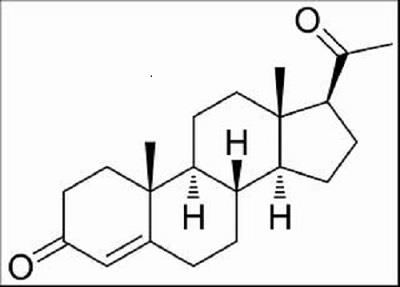The Mystery of Progesterone: Decoding the "Key" to Life
Jun 25,2024
Introduction
In the vast field of life science, progesterone has attracted the attention of many researchers with its unique charm and complexity. It is not only an indispensable member of the female reproductive system but also plays a pivotal role in the pregnancy, development, and maintenance of life. This article will walk you down the mystery of progesterone and dig into the mystery of this "key" to life.1

Biological characteristicsProgesterone
also known as progesterone, is a natural progesterone produced by the lutein cells of the ovary and the placenta of pregnancy. It plays a vital role in the female reproductive cycle, pregnancy, and embryonic development. Its biological characteristics are mainly manifested in the following aspects:
Regulate the menstrual cycle
It works in synergy with estrogen to jointly regulate the menstrual cycle of women. After ovulation, the luteal cells of the ovary secrete progesterone to transform the endometrium from a proliferative phase to a secretory phase to prepare for implantation and development of the fertilized egg.
Maintenance of pregnancy
It plays a vital role in the pregnancy process. It can promote the decidualization of the endometrium, reduce the excitability of the uterus, inhibit uterine contraction, and thus maintain the stability of pregnancy. In addition, progesterone can also promote the development of mammary glands, in preparation for breastfeeding.
Participate in embryonic development
It also plays an important role in the embryonic development process. It can promote the implantation and development of the embryo and enhance the adaptability of the embryo to the mother. In addition, it can also regulate the sex differentiation of embryos and affect the sex ratio of embryos.2

Research progress of non-gene effects
The traditional viewpoint is that progesterone functions to regulate the pregnancy hormone nuclear receptor (nPR), that is, it diffuses freely through the plasma membrane and binds tightly to nPR to regulate gene expression or interact with other nuclear proteins to change the transcriptional activity of genes by binding to hormone response elements (HRE) on target genes. However, studies in recent years have found that it also has non-genetic effects that do not rely on the transcriptional activity of NPR, but act directly through membrane receptors or other signaling pathways.3
Non-gene action of Progesterone is fast and straightforward and can produce biological effects in a short time. At present, studies have shown that its non-genetic effects mainly include the following aspects:
Rapid regulation of ion channels
It can directly act on ion channels on the cell membrane, such as potassium ion channels, calcium ion channels, etc., to quickly regulate the electrophysiological characteristics of cells.
Activate signaling pathway
progesterone can activate various signaling pathways, such as MAPK, PI3K/Akt, etc., to regulate the biological processes of cell proliferation, differentiation, and apoptosis.
Regulation of the cytoskeleton
It can affect the composition and stability of the cytoskeleton, thereby regulating the morphology and function of cells.
Progesterone and breast cancer risk
In recent years, research on its association with breast cancer risk has received much attention. Studies have shown that long-term use of pregnancy-based contraceptives may increase the risk of breast cancer. However, this conclusion remains controversial. Some studies have suggested that the breast cancer risk of pregnancy-based contraceptives is similar to that of other hormonal contraceptives and that the overall risk is lower. Therefore, when using it, you should weigh the pros and cons according to your situation and follow your doctor's advice and guidance.4
Challenges and prospects in clinical application
It has a wide application prospect in clinical application, but it also faces some challenges. On the one hand, the mechanism of action of progesterone is complex and diverse, and its effect and safety are affected by many factors, such as dose, administration mode, individual differences, and so on. Therefore, in clinical application, it is necessary to consider the specific situation of patients and develop personalized treatment plans. On the other hand, the side effects and adverse reactions of progesterone also need to be paid enough attention. Common side effects of progesterone include nausea, vomiting, headache, breast tenderness, etc. Large doses may also lead to serious complications such as water and sodium retention. Therefore, it is necessary to pay attention to monitoring patients' vital signs and adverse reactions when using it and adjust the treatment plan in time.5
Looking forward to the future, with the in-depth study of the mechanism of progesterone and the continuous emergence of new technologies, it will have a broader prospect in clinical application. For example, gene editing technology can accurately regulate the expression and function of progesterone, providing new ideas and methods for the treatment of related diseases. In addition, its combined application with other drugs will also become one of the future research hotspots, by optimizing the drug combination and administration mode, improving the therapeutic effect, and reducing side effects.
Conclusion
As the "key" of life, progesterone plays an important role in the female reproductive cycle, pregnancy, and embryonic development. With further study of its mechanism of action and the emergence of new technologies, we will have a deeper understanding of the mystery of this amazing hormone journey. In future studies, we need to continue to explore its new role and new mechanisms to provide new ideas and methods for the prevention and treatment of related diseases. At the same time, we also need to pay attention to the challenges and prospects of its clinical application to protect the health of patients.
References
[1].Maggio, L.; Rouse, D. J., Progesterone. Clinical obstetrics and gynecology 2014, 57 (3), 547-556.
[2].Short, R. V., Progesterone in blood. Journal of Endocrinology 1958, 16 (4), 415-425.
[3].Genazzani, A.; Stomati, M.; Morittu, A.; Bernardi, F.; Monteleone, P.; Casarosa, E.; Gallo, R.; Salvestroni, C.; Luisi, M., Progesterone, progestagens and the central nervous system. Human Reproduction 2000, 15 (suppl_1), 14-27.
[4].Taraborrelli, S., Physiology, production and action of progesterone. Acta obstetricia et gynecologica Scandinavica 2015, 94, 8-16.
[5].Cable, J. K.; Grider, M. H., Physiology, progesterone. 2020.
- Related articles
- Related Qustion
- Biological functions and use of Progesterone Jun 15, 2022
Progesterone (P4) is a steroid hormone and an intermediate of sex steroids produced by all steroidogenic tissues.
- Physiological effects of progesterone Apr 11, 2022
Progesterone, also known as progesterone hormone and progesterone hormone, is the main biologically active progesterone secreted by the ovary.
Sulfanilamide is a synthetic antimicrobial agent, which works by inhibiting the enzyme dihydropteroate synthase in bacteria.....
Jun 25,2024APID-(+)-Glucono-1,5-lactone (GDL or lactone), as an important compound, plays multiple roles in the food industry such as coagulant, stabilizer, sour agent.....
Jun 25,2024APIProgesterone
57-83-0You may like
- What is albendazole used for?
Jul 10, 2024
- X-PHOS: Properties and Applications as Catalyst
Jul 10, 2024
- Phenacetin: A Comprehensive Overview for Chemistry Professionals
Jul 10, 2024
- Progesterone
-

- $0.00 / 1kg
- 2024-07-10
- CAS:57-83-0
- Min. Order: 1kg
- Purity: 98%
- Supply Ability: no limitation
- Progesterone
-

- $1.00 / 1kg
- 2024-07-10
- CAS:57-83-0
- Min. Order: 1kg
- Purity: 99%
- Supply Ability: 100kg
- Progesterone
-

- $0.00 / 1kg
- 2024-07-10
- CAS:57-83-0
- Min. Order: 1kg
- Purity: 99%
- Supply Ability: 500




